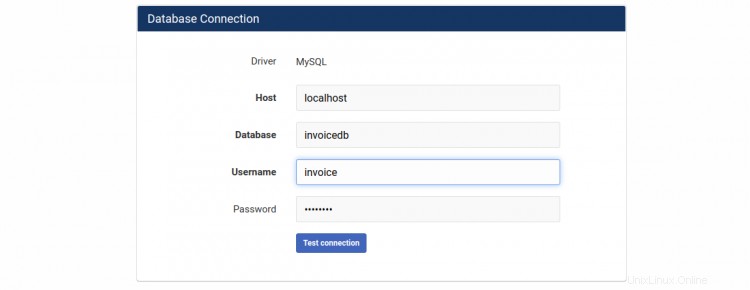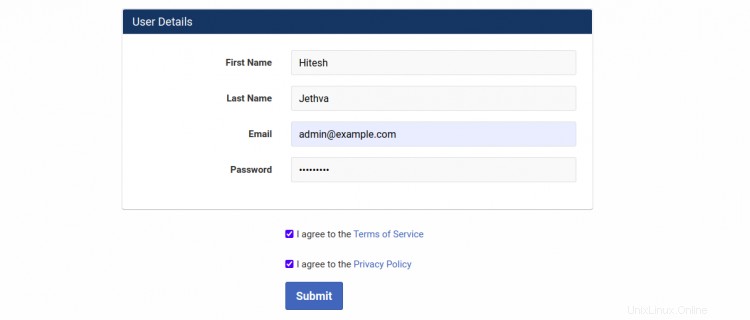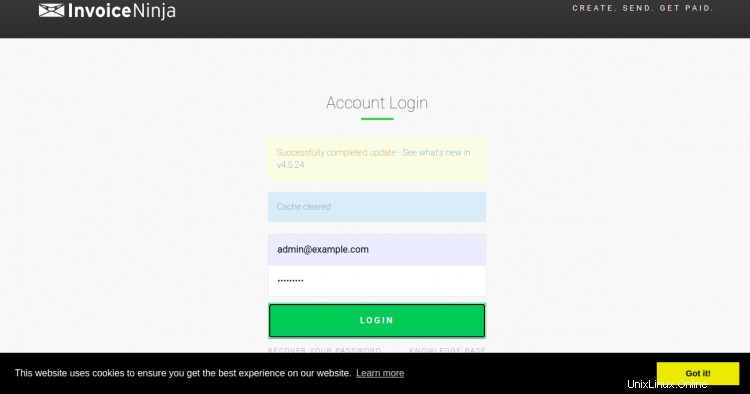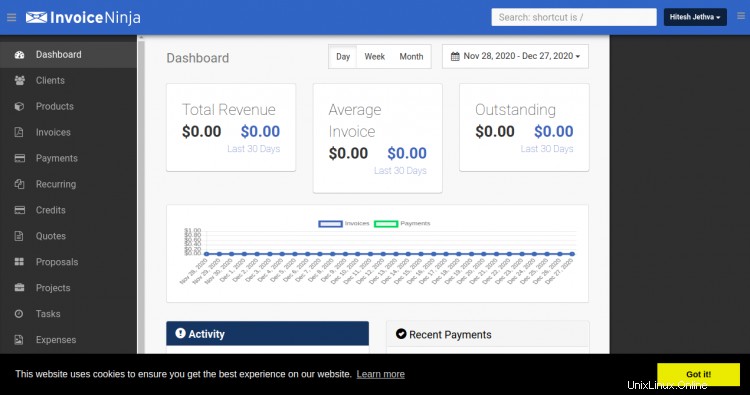Invoice Ninja è un'app di fatturazione online gratuita e open source per liberi professionisti e aziende che ti aiuta ad accettare pagamenti, tenere traccia delle spese, creare proposte e impegni di tempo. È un'applicazione di fatturazione self-hosted molto simile alle applicazioni di fatturazione commerciale come Freshbooks. Ti consente di creare la tua fattura personalizzata e inviarla online in un secondo.
Invoice Ninja è molto utile per le piccole e medie imprese. Se stai cercando un software di fatturazione sicuro e facile da usare, Invoice Ninja è l'opzione migliore per te.
In questo tutorial, ti mostreremo come installare Invoice Ninja con Apache e Let's Encrypt SSL sul server Ubuntu 20.04.
Prerequisiti
- Un server che esegue Ubuntu 20.04.
- Un nome di dominio valido puntato all'IP del tuo server.
- Una password di root è configurata sul server.
Per iniziare
Innanzitutto, si consiglia di aggiornare i pacchetti di sistema all'ultima versione. Esegui il comando seguente per aggiornare tutti i pacchetti:
apt-get update -y
Una volta aggiornati tutti i pacchetti, installa le altre dipendenze richieste con il seguente comando:
apt-get install software-properties-common apt-transport-https ca-certificates gnupg2 -y
Una volta installate tutte le dipendenze, puoi procedere al passaggio successivo.
Installa il server LAMP
Successivamente, dovrai installare Apache, MariaDB e PHP sul tuo sistema. Innanzitutto, installa i pacchetti Apache e MariaDB con il seguente comando:
apt-get install apache2 mariadb-server -y
Dopo aver installato entrambi i pacchetti, dovrai installare PHP versione 7.2 e altre estensioni nel tuo sistema.
Per impostazione predefinita, Ubuntu 20.04 viene fornito con la versione PHP 7.4. Quindi dovrai aggiungere il repository Ondrej al tuo sistema.
Puoi aggiungere il repository PHP Ondrej con il seguente comando:
add-apt-repository ppa:ondrej/php
Una volta aggiunto il repository, installa PHP e altre estensioni con il seguente comando:
apt-get install php7.2 libapache2-mod-php7.2 php-imagick php7.2-fpm php7.2-mysql php7.2-common php7.2-gd php7.2-json php7.2-curl php7.2-zip php7.2-xml php7.2-mbstring php7.2-bz2 php7.2-intl php7.2-gmp unzip -y
Dopo aver installato tutti i pacchetti, verifica la versione installata di PHP con il seguente comando:
php -v
Dovresti vedere il seguente output:
PHP 7.2.34-8+ubuntu20.04.1+deb.sury.org+1 (cli) (built: Oct 31 2020 16:57:33) ( NTS )
Copyright (c) 1997-2018 The PHP Group
Zend Engine v3.2.0, Copyright (c) 1998-2018 Zend Technologies
with Zend OPcache v7.2.34-8+ubuntu20.04.1+deb.sury.org+1, Copyright (c) 1999-2018, by Zend Technologies
Configura il database MariaDB
Successivamente, dovrai creare un database e un utente per Invoice Ninja. Innanzitutto, accedi alla console MariaDB con il seguente comando:
mysql
Una volta effettuato l'accesso, crea un database e un utente con il seguente comando:
MariaDB [(none)]> create database invoicedb;
MariaDB [(none)]> create user [email protected] identified by 'password';
Quindi, concedi tutti i privilegi a fatturadb con il seguente comando:
MariaDB [(none)]> grant all privileges on invoicedb.* to [email protected];
Quindi, svuota i privilegi ed esci dalla console MariaDB con il seguente comando:
MariaDB [(none)]> flush privileges;
MariaDB [(none)]> exit;
Una volta terminato, puoi procedere al passaggio successivo.
Installa Invoice Ninja
Innanzitutto, scarica l'ultima versione di Invoice Ninja dal suo sito Web ufficiale:
wget -O invoice-ninja.zip https://download.invoiceninja.com/
Una volta completato il download, decomprimere il file scaricato nella directory principale di Apache utilizzando il seguente comando:
unzip invoice-ninja.zip -d /var/www/html/
Quindi, imposta le autorizzazioni e la proprietà appropriate con il seguente comando:
chown -R www-data:www-data /var/www/html/ninja
chmod -R 755 /var/www/html/ninja
Una volta terminato, puoi procedere al passaggio successivo.
Configura Apache per Invoice Ninja
Successivamente, dovrai creare un file di configurazione dell'host virtuale apache per Invoice Ninja. Puoi crearlo con il seguente comando:
nano /etc/apache2/sites-available/ninja.conf
Aggiungi le seguenti righe:
<VirtualHost *:80>
ServerName invoice.example.com
DocumentRoot /var/www/html/ninja/public
<Directory /var/www/html/ninja/public>
DirectoryIndex index.php
Options +FollowSymLinks
AllowOverride All
Require all granted
</Directory>
ErrorLog ${APACHE_LOG_DIR}/invoice-ninja.error.log
CustomLog ${APACHE_LOG_DIR}/invoice-ninja.access.log combined
Include /etc/apache2/conf-available/php7.2-fpm.conf
</VirtualHost>
Salva e chiudi il file, quindi abilita il file host virtuale con il seguente comando:
a2ensite ninja.conf
Quindi, abilita i moduli Apache richiesti usando il seguente comando:
a2enmod mpm_event proxy_fcgi setenvif
a2enmod rewrite
Infine, riavvia il servizio Apache per applicare le modifiche:
systemctl restart apache2
Ora puoi verificare lo stato dell'Apache usando il seguente comando:
systemctl status apache2
Dovresti ottenere il seguente output:
? apache2.service - The Apache HTTP Server
Loaded: loaded (/lib/systemd/system/apache2.service; enabled; vendor preset: enabled)
Active: active (running) since Sun 2020-12-27 07:15:15 UTC; 11s ago
Docs: https://httpd.apache.org/docs/2.4/
Process: 25097 ExecStart=/usr/sbin/apachectl start (code=exited, status=0/SUCCESS)
Main PID: 25113 (apache2)
Tasks: 55 (limit: 2353)
Memory: 5.3M
CGroup: /system.slice/apache2.service
??25113 /usr/sbin/apache2 -k start
??25114 /usr/sbin/apache2 -k start
??25115 /usr/sbin/apache2 -k start
Dec 27 07:15:15 ubuntu systemd[1]: Starting The Apache HTTP Server..
A questo punto, Apache è configurato per servire Invoice Ninja. Ora puoi procedere al passaggio successivo.
Accedi a Invoice Ninja
Ora apri il tuo browser web e accedi a Invoice Ninja utilizzando l'URL http://invoice.example.com . Verrai reindirizzato alla seguente pagina:



Fornisci l'URL del tuo sito web, i dettagli del database, il nome utente e la password dell'amministratore e fai clic su Invia pulsante. Verrai reindirizzato alla schermata di accesso di Invoice Ninja:

Fornisci il nome utente e la password dell'amministratore e fai clic su LOGIN pulsante. Dovresti vedere la dashboard di Invoice Ninja nella schermata seguente:

Secure Invoice Ninja con Let's Encrypt SSL
È sempre una buona idea proteggere il tuo sito Web con Let's Encrypt SSL. Sarà necessario installare il client Certbot per installare e gestire SSL. Puoi installarlo con il seguente comando:
apt-get install python3-certbot-apache -y
Una volta installato Certbot, esegui il comando seguente per proteggere il tuo sito Web con Let's Encrypt SSL:
certbot --apache -d invoice.example.com
Ti verrà chiesto di fornire la tua email e di accettare i termini del servizio come mostrato di seguito:
Saving debug log to /var/log/letsencrypt/letsencrypt.log Plugins selected: Authenticator standalone, Installer None Enter email address (used for urgent renewal and security notices) (Enter 'c' to cancel): [email protected] - - - - - - - - - - - - - - - - - - - - - - - - - - - - - - - - - - - - - - - - Please read the Terms of Service at https://letsencrypt.org/documents/LE-SA-v1.2-November-15-2017.pdf. You must agree in order to register with the ACME server at https://acme-v02.api.letsencrypt.org/directory - - - - - - - - - - - - - - - - - - - - - - - - - - - - - - - - - - - - - - - - (A)gree/(C)ancel: A - - - - - - - - - - - - - - - - - - - - - - - - - - - - - - - - - - - - - - - - Would you be willing to share your email address with the Electronic Frontier Foundation, a founding partner of the Let's Encrypt project and the non-profit organization that develops Certbot? We'd like to send you email about our work encrypting the web, EFF news, campaigns, and ways to support digital freedom. - - - - - - - - - - - - - - - - - - - - - - - - - - - - - - - - - - - - - - - - (Y)es/(N)o: Y Plugins selected: Authenticator apache, Installer apache Obtaining a new certificate Performing the following challenges: http-01 challenge for invoice.example.com Enabled Apache rewrite module Waiting for verification... Cleaning up challenges Created an SSL vhost at /etc/apache2/sites-available/invoice-le-ssl.conf Enabled Apache socache_shmcb module Enabled Apache ssl module Deploying Certificate to VirtualHost /etc/apache2/sites-available/invoice-le-ssl.conf Enabling available site: /etc/apache2/sites-available/invoice-le-ssl.conf
Quindi, seleziona se reindirizzare o meno il traffico HTTP su HTTPS come mostrato di seguito:
Please choose whether or not to redirect HTTP traffic to HTTPS, removing HTTP access. - - - - - - - - - - - - - - - - - - - - - - - - - - - - - - - - - - - - - - - - 1: No redirect - Make no further changes to the webserver configuration. 2: Redirect - Make all requests redirect to secure HTTPS access. Choose this for new sites, or if you're confident your site works on HTTPS. You can undo this change by editing your web server's configuration. - - - - - - - - - - - - - - - - - - - - - - - - - - - - - - - - - - - - - - - - Select the appropriate number [1-2] then [enter] (press 'c' to cancel): 2
Digita 2 e premi Invio per installare Let's Encrypt SSL per il tuo sito web:
Enabled Apache rewrite module Redirecting vhost in /etc/apache2/sites-enabled/invoice.conf to ssl vhost in /etc/apache2/sites-available/invoice-le-ssl.conf - - - - - - - - - - - - - - - - - - - - - - - - - - - - - - - - - - - - - - - - Congratulations! You have successfully enabled https://invoice.example.com You should test your configuration at: https://www.ssllabs.com/ssltest/analyze.html?d=invoice.example.com - - - - - - - - - - - - - - - - - - - - - - - - - - - - - - - - - - - - - - - - IMPORTANT NOTES: - Congratulations! Your certificate and chain have been saved at: /etc/letsencrypt/live/invoice.example.com/fullchain.pem Your key file has been saved at: /etc/letsencrypt/live/invoice.example.com/privkey.pem Your cert will expire on 2020-10-23. To obtain a new or tweaked version of this certificate in the future, simply run certbot again with the "certonly" option. To non-interactively renew *all* of your certificates, run "certbot renew" - If you like Certbot, please consider supporting our work by: Donating to ISRG / Let's Encrypt: https://letsencrypt.org/donate Donating to EFF: https://eff.org/donate-le
Ora puoi accedere al tuo sito web in modo sicuro utilizzando l'URL https://invoice.example.com.
Conclusione
Congratulazioni! hai installato e configurato correttamente Invoice Ninja con Let's Encrypt SSL sul server Ubuntu 20.04. Ora puoi esplorare Invoice Ninja per ulteriori funzionalità e distribuirlo nell'ambiente di produzione. Sentiti libero di chiedermi se hai domande.